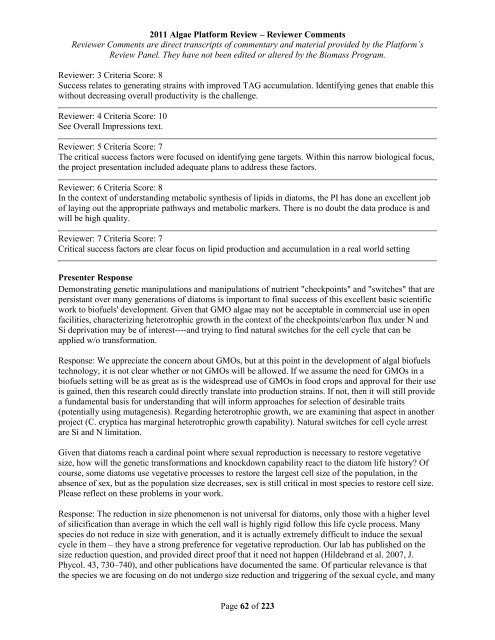Reviewer Comments - EERE
Reviewer Comments - EERE
Reviewer Comments - EERE
Create successful ePaper yourself
Turn your PDF publications into a flip-book with our unique Google optimized e-Paper software.
2011 Algae Platform Review – <strong>Reviewer</strong> <strong>Comments</strong><br />
<strong>Reviewer</strong> <strong>Comments</strong> are direct transcripts of commentary and material provided by the Platform’s<br />
Review Panel. They have not been edited or altered by the Biomass Program.<br />
<strong>Reviewer</strong>: 3 Criteria Score: 8<br />
Success relates to generating strains with improved TAG accumulation. Identifying genes that enable this<br />
without decreasing overall productivity is the challenge.<br />
<strong>Reviewer</strong>: 4 Criteria Score: 10<br />
See Overall Impressions text.<br />
<strong>Reviewer</strong>: 5 Criteria Score: 7<br />
The critical success factors were focused on identifying gene targets. Within this narrow biological focus,<br />
the project presentation included adequate plans to address these factors.<br />
<strong>Reviewer</strong>: 6 Criteria Score: 8<br />
In the context of understanding metabolic synthesis of lipids in diatoms, the PI has done an excellent job<br />
of laying out the appropriate pathways and metabolic markers. There is no doubt the data produce is and<br />
will be high quality.<br />
<strong>Reviewer</strong>: 7 Criteria Score: 7<br />
Critical success factors are clear focus on lipid production and accumulation in a real world setting<br />
Presenter Response<br />
Demonstrating genetic manipulations and manipulations of nutrient "checkpoints" and "switches" that are<br />
persistant over many generations of diatoms is important to final success of this excellent basic scientific<br />
work to biofuels' development. Given that GMO algae may not be acceptable in commercial use in open<br />
facilities, characterizing heterotrophic growth in the context of the checkpoints/carbon flux under N and<br />
Si deprivation may be of interest----and trying to find natural switches for the cell cycle that can be<br />
applied w/o transformation.<br />
Response: We appreciate the concern about GMOs, but at this point in the development of algal biofuels<br />
technology, it is not clear whether or not GMOs will be allowed. If we assume the need for GMOs in a<br />
biofuels setting will be as great as is the widespread use of GMOs in food crops and approval for their use<br />
is gained, then this research could directly translate into production strains. If not, then it will still provide<br />
a fundamental basis for understanding that will inform approaches for selection of desirable traits<br />
(potentially using mutagenesis). Regarding heterotrophic growth, we are examining that aspect in another<br />
project (C. cryptica has marginal heterotrophic growth capability). Natural switches for cell cycle arrest<br />
are Si and N limitation.<br />
Given that diatoms reach a cardinal point where sexual reproduction is necessary to restore vegetative<br />
size, how will the genetic transformations and knockdown capability react to the diatom life history? Of<br />
course, some diatoms use vegetative processes to restore the largest cell size of the population, in the<br />
absence of sex, but as the population size decreases, sex is still critical in most species to restore cell size.<br />
Please reflect on these problems in your work.<br />
Response: The reduction in size phenomenon is not universal for diatoms, only those with a higher level<br />
of silicification than average in which the cell wall is highly rigid follow this life cycle process. Many<br />
species do not reduce in size with generation, and it is actually extremely difficult to induce the sexual<br />
cycle in them – they have a strong preference for vegetative reproduction. Our lab has published on the<br />
size reduction question, and provided direct proof that it need not happen (Hildebrand et al. 2007, J.<br />
Phycol. 43, 730–740), and other publications have documented the same. Of particular relevance is that<br />
the species we are focusing on do not undergo size reduction and triggering of the sexual cycle, and many<br />
Page 62 of 223




